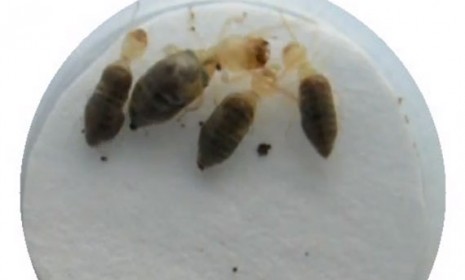What termites and suicide bombers have in common
When faced by attackers, the termite species Neocapritermes taracua sends out kamikaze bugs equipped with explosive, venom-filled pouches

Deep in the rainforests of French Guiana, a unique species of termite has a curious way of dealing with invaders. When enemy termites attack the nest, Neocapritermes taracua sends out older worker bugs to act as "suicide bomb" attackers, spewing forth a deadly blue liquid. Here's what you should know:
How do the termites explode?
The termites are equipped with what are essentially "explosive backpacks." Over their lifetime, the termites produce toxic blue crystals using a pair of glands in the abdomen, and then store them in an external pouch. When enemy termites, such as Labiotermes labralis, attack the nest, older worker bugs are sent to the front lines along with soldier bugs. The poisonous blue crystals they have amassed react with salivary gland secretions to create a type of "toxic goo." When an enemy takes a bite, the explosive backpack ruptures, covering nearby foes in a deadly, paralyzing venom that also kills the worker in the process.
The Week
Escape your echo chamber. Get the facts behind the news, plus analysis from multiple perspectives.

Sign up for The Week's Free Newsletters
From our morning news briefing to a weekly Good News Newsletter, get the best of The Week delivered directly to your inbox.
From our morning news briefing to a weekly Good News Newsletter, get the best of The Week delivered directly to your inbox.
How are scientists able to tell how old they are?
As termites get older, their mandibles become dull and worn out. These pincer-like mouths can't be sharpened by molting, and grow apart as they age. Because of this, scientists can measure the mandibles from edge to edge to approximate the age of a termite.
Why send out older bugs?
Two reasons: First, "older individuals are not as effective at foraging and nest maintenance as younger works," says Robert Hanus, a termite biology expert at the Institute of Organic Chemistry and Biochemistry in Prague. Second, elderly bugs carry the largest and most toxic backpacks, which they've spent a lifetime filling. The termite's suicide gear is "highly unusual in the world of insect warfare," says Wynne Parry at LiveScience, because the combo of blue crystals and salivatory secretions makes it a "two-component system." The sophistication "is remarkable," says Olav Ruepell, an evolutionary biologist at the University of North Carolina. "We have never seen an external pouch like this before" that requires one substance to be mixed with another substance.
A free daily email with the biggest news stories of the day – and the best features from TheWeek.com
Is this the weirdest defense mechanism found on termites?
Actually, many species of the chompy insects regularly "engage in chemical warfare," says Ed Yong at Discover Magazine. Some bugs squirt noxious chemicals from head-mounted nozzles. Other species of termites "violently rupture their bodies" to release sticky fluids, impeding any would-be attackers. These exploding backpacks are just the latest strange evolutionary weapon scientists have discovered.
Sources: BBC News, Discover Magazine, LiveScience, Nature
-
 What Nick Fuentes and the Groypers want
What Nick Fuentes and the Groypers wantThe Explainer White supremacism has a new face in the US: a clean-cut 27-year-old with a vast social media following
-
 5 highly amusing cartoons about rising health insurance premiums
5 highly amusing cartoons about rising health insurance premiumsCartoon Artists take on the ACA, Christmas road hazards, and more
-
 Codeword: December 21, 2025
Codeword: December 21, 2025The daily codeword puzzle from The Week